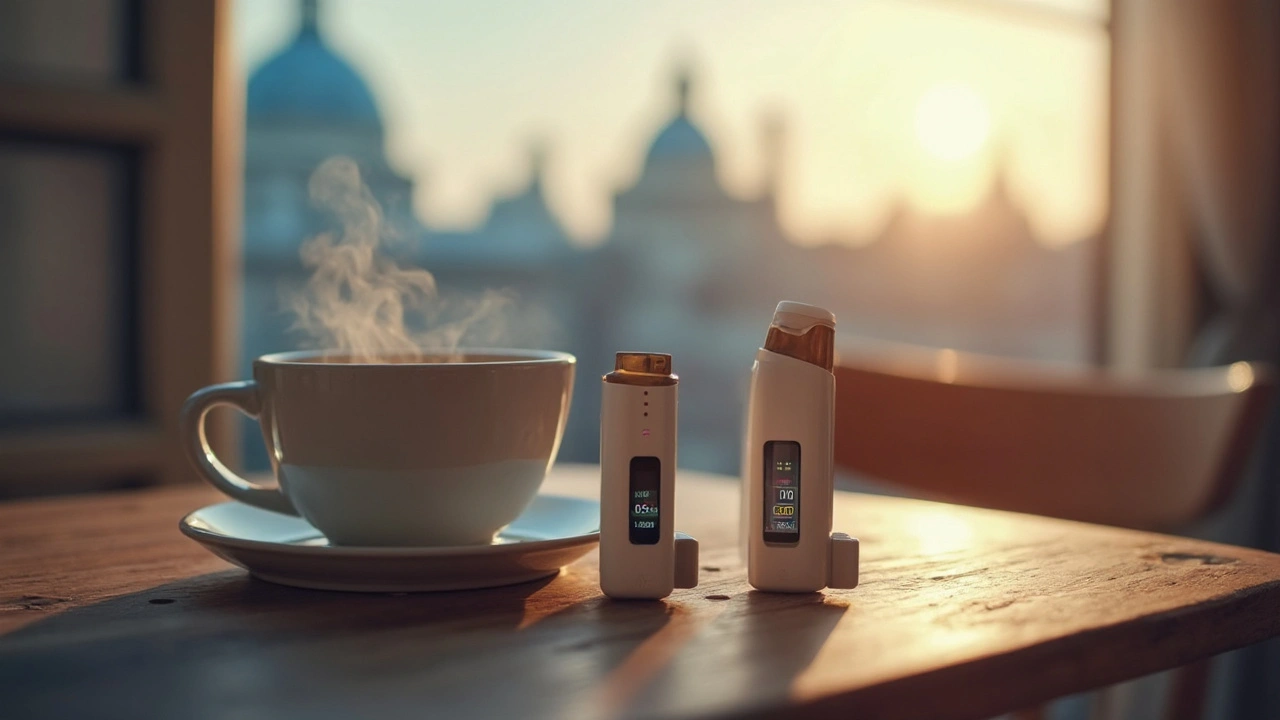
Here’s a wild fact: over 25 million Americans—kids, adults, and plenty in between—rely on inhalers just to get through the day. For a long time, Symbicort (that’s budesonide and formoterol, if you’re geeking out on names) was the gold standard for managing asthma and COPD. It was reliable, kept symptoms in check, and didn’t make most folks cough up half their salary at the pharmacy. But medicine doesn’t sit still, and suddenly 2025 feels like the year everything’s changing. Big-name pharma companies, plus a couple of scrappy newcomers, are rolling out dual- and triple-therapy inhalers that aim to do what Symbicort did—and then some. Think longer-lasting control, fewer side effects, even digital helpers baked into the inhaler. The buzz is real, and so are people’s hopes for something better than the old standbys.
Why Symbicort Needed an Update: Patients and Doctors Weigh In
You might wonder, if Symbicort worked fine, why mess with it? The answer comes straight from the folks using inhalers day in and day out. Plenty of people saw gaps in relief, had nagging side effects, or just wanted less hassle. Symbicort combined a steroid and a long-acting beta-agonist—solid idea, but sometimes not enough, especially for those with tough-to-manage COPD or asthma that liked to flare up at all the wrong times. And the price? Ouch. As generics started rolling out, budgets eased, but some found the new generics didn’t quite deliver the same results or smoothness of the brand.
Doctors got tired of playing medication roulette. Some patients needed more than two drugs. Others wanted an inhaler they could truly trust not to skip a beat, even on bad days. Oh, and everyone wanted fewer steps in their daily routine—no one loves juggling three different puffers. Through surveys done by the National Heart, Lung, and Blood Institute, most users pointed to either incomplete control (meaning symptoms crept in anyway) or side effects like hoarseness, jitteriness, and, oddly enough, weird taste.
So, the call went out for better. Pharma listened. Enter the new wave of inhalers—dual-therapy with more targeted delivery and triple-therapy for those who’ve been playing medication hopscotch for years. They promise stability, faster relief, and, in some cases, smart tech to track your usage so you never run dry at the worst moment (looking at you, allergy season in Minneapolis).
Meet the Dual-Therapy Competitors: Moving Beyond Budesonide/Formoterol
This is where the race heats up. Dual-therapy inhalers work by combining two types of medicine, just like Symbicort, but with new combinations and delivery methods. In 2025, the U.S. market has seen the rollout of:
- Fluticasone Furoate/Vilanterol (Breo Ellipta): This once-a-day inhaler isn’t brand-new, but its upgraded version now boasts an adjusted dose for even steadier control. The cool bit? Ellipta’s device gives feedback if you’ve taken a full dose, a huge plus for anyone who’s ever wondered, "Did I actually get that dose?"
- Mometasone/Formoterol (Dulera): Still trusted, but 2025 brought a tweak to its particle size for deeper lung reach, based on the results from the MetaCOPD phase-4 trial published this spring. Think fewer exacerbations, which means fewer ER visits.
- And don’t forget some names you’ll start hearing more—like Bevespi Aerosphere (glycopyrrolate/formoterol), which muscles in with a LAMA/LABA combo, and is turning heads for people with overlapping asthma and COPD.
Price tags? The market’s shifting, but Breo Ellipta’s new version hovers just below the old Symbicort price, and Dulera’s generic option is finally rolling out to more insurance plans (as per Pharmacy Times' April report).
Still, the dual combos aren’t just about money. They’re armed with tech—some have dose counters, some sync with apps to remind you, "Hey, don’t forget your puff!" The FDA even greenlit Ellipta’s new Digital Companion, tracking inhaler usage and sharing it through a HIPAA-compliant cloud if you let it. Easier breathing, less guesswork.

Triple-Therapy Inhalers: When Asthma and COPD Refuse to Play Nice
If you’ve ever juggled two inhalers and still felt out of breath, triple-therapy inhalers might sound like magic. These products combine three medications—usually a steroid, a long-acting beta-agonist, and a long-acting muscarinic antagonist—in one canister. No more carrying two (or three) devices. The idea? Attack inflammation, smooth out airways, and relax them all at once.
- Trelegy Ellipta (Fluticasone Furoate/Umeclidinium/Vilanterol): This one’s had a presence in Europe and the U.S. since before 2025, but new post-market studies are catching everyone’s attention. A 2024 analysis from the Journal of Pulmonology pointed out a 41% drop in COPD flare-ups compared to dual-therapy alone.
- Breztri Aerosphere (Budesonide/Glycopyrrolate/Formoterol): Launched in more states this year, Breztri’s real-world approval ratings are climbing, especially among adults with both COPD and frequent asthma attacks.
- And a dark horse: TrioFim (still in its early rollout), promising fewer throat infections—its delivery method targets the lungs but is gentler on the mouth and throat.
Doctors are finally getting the one-and-done option they’ve been waiting for. Triple-therapy isn’t for everyone (it’s usually reserved for more persistent or severe cases), but the people who need it know just how big a deal it is to cut back on device confusion. Insurance is catching up—Medicare and several big private insurers slotted Trelegy and Breztri into preferred tiers as of March 2025.
To make sense of side effects and costs, here’s a snapshot:
| Inhaler | Typical Price (30 Days) | Common Side Effects | Key Benefit |
|---|---|---|---|
| Trelegy Ellipta | $590 (with insurance: $45 copay avg.) | Hoarseness, headache | One inhaler for triple action |
| Breztri Aerosphere | $640 (with assistance: $35) | Dry mouth, cough | Faster attack recovery |
| Symbicort (generic) | $280 | Throat irritation, jitteriness | Tried-and-true option |
Insurance, Access, and Digital Perks: Making the Switch
When you consider switching inhalers, you can’t just look at the medical chart. Costs matter—a lot. For most people, insurance decides what’s affordable. In 2025, more plans are nudging members toward generics, but many are also bringing triple-therapy options into preferred tiers. UnitedHealthcare, for example, added both Trelegy and Breztri as of February. That means lower copays and, sometimes, full coverage for high-risk groups.
Pharmacy discount cards and manufacturer coupons aren’t gone, either, but the real game-changer is support programs tied to new inhalers. Trelegy’s MyAirGuide and Breztri’s Airstream now have phone apps to help track symptoms, offer refill reminders, and—if you want—share your usage securely with your doc to spot trends or compliance issues. Not every insurance company covers all inhalers, though, so double-check the formulary list before your next prescription refill.
Some smart inhalers even greet you—a persistent voice reminding you to inhale (Stanley, my Labrador, now looks at me every time mine "talks"). Can’t say he approves, but it keeps me honest. People seem to like these reminders, too, with Asthma & COPD News reporting that 78% of users felt it helped their routine, especially in stressful weeks when remembering the morning puff gets tricky.
If you’re thinking about a change or just want a broader look, I’d recommend checking out some curated lists of Symbicort replacement options for a real-world glimpse of how folks are adjusting in 2025. They break down user reviews and even list pharmacies where you can find the best deals—handy if you’re sick of endless insurance hold music.

Getting Ready for the Next Step: How to Switch, What to Ask, and What to Watch For
Trading old for new sounds easy, but switching inhalers comes with headaches if you’re not prepared. Doctors will want to make sure you’re stepping up to dual- or triple-therapy for the right reason. That means a checkup (often with lung function testing) and a talk about any weird side effects or symptom patterns. The more honest you are about what’s happening day-to-day, the better your chance of landing an inhaler that actually fits your life.
- First, get a list of what’s covered on your plan. Sometimes switching is prompted purely by insurance changes, and knowing your options saves time.
- Next, ask your pharmacist or doctor about device details. If arthritis makes twisting difficult or you’re prone to forgetting, a push-button or digital inhaler could be a lifesaver (literally).
- If you travel or move around a lot, ask about how to store your inhaler—some of the new ones have specific temperature needs, which I learned the hard way lugging mine to a summer cabin (Stanley didn’t mind the trip, but my lungs noticed the difference!).
One pro tip: Always keep a bit of your old inhaler on hand when first switching, just in case you and your lungs need a “plan B” while you adjust. Talk with your doctor about a rescue inhaler, too—it doesn’t go away, even with these new combos. The key is getting clear about your reality. Don’t settle for an inhaler that “sort of works” when the market in 2025 is finally giving us real choices for asthma and COPD. So breathe deep—you have more backup than ever.



Finally, some real progress. I’ve been on Symbicort for 8 years and my lungs have been begging for a change. Breztri’s been a game-changer-no more jittery hands, and I actually remember to use it because the app pings me. Stanley the dog is jealous I’m not coughing as much anymore. 🐶❤️
Of course the pharma giants are pushing this. They’ve been quietly buying up the small biotech startups that actually made these inhalers. You think they care about your breathing? They care about your insurance copay. The ‘digital companion’? That’s surveillance with a Nebulizer.
Did you know the FDA approved Trelegy right after the CEO of GlaxoSmithKline donated $12M to the National Heart, Lung, and Blood Institute? Coincidence? 😏 I’ve got receipts. They’re testing these on us like lab rats. Also, the ‘smart inhaler’ tracks your location. Why? So they can charge you more if you live in a high-pollution zip code. 🤔💊
Wow. So now we’re supposed to trust Big Pharma more because they added an app? Meanwhile, my neighbor’s kid got asthma from glyphosate in the school playground and no one’s talking about that. You’re all just chasing shiny gadgets while the real poison is still in the air. 🤦♀️
I get why people are skeptical, but honestly? My mom switched to Breztri last year after three ER visits. She’s been stable for 11 months. The app reminds her to hydrate too-turns out, dry mouth isn’t just a side effect, it’s a sign she’s not drinking enough. It’s not magic, but it’s helping. Maybe that’s enough for now? 🙏
Let me be clear: the fact that we’re even having this conversation is a triumph of medical innovation, and yet-some of us are still clinging to the past like it’s a security blanket. Symbicort was a milestone, yes-but it was never the destination. The new inhalers? They’re not just better; they’re smarter, quieter, and more dignified. And yes, the digital features? They’re not creepy-they’re compassionate.
USA best inhalers. All other countries are just copying us. Also, Trelegy is literally made in America (well, the parts that matter). If you’re using a foreign-made inhaler, you’re basically helping China win the respiratory Olympics. 🇺🇸💪
Ah, the commodification of breath-a metaphysical tragedy masked as pharmaceutical progress. We have traded the sacred act of inhaling for algorithmic reminders and corporate-sponsored compliance. The inhaler is no longer a tool of liberation; it is a cyborg limb, tethered to a cloud server, whispering in HIPAA-compliant tones: ‘You are being monitored, citizen.’ The lungs, once free, now obey the Wi-Fi signal. What is freedom, if not the ability to cough without a notification?
So what? It’s still expensive. And why do we need apps for breathing? Just take your puff and be done. People these days want everything to be a phone game.
you think you’re smart for using the app? i’ve been using the same inhaler since 2010 and i’ve never once missed a dose. no app. no buzz. no digital overlord. just me, my lungs, and a little plastic tube. the future is just… overcomplicated. 🤷♂️
In India, we still wait months for basic inhalers. These new ones sound wonderful, but I wonder how many people will ever see them. Technology is beautiful, but not if it leaves the poor behind. Maybe we should fix access before we fix the device.
My sister just switched to Trelegy and she’s been smiling for the first time in years. She says she feels like she can finally take a full breath again. That’s worth more than any price tag. 💕
Let’s be clear: if you’re still using Symbicort in 2025, you’re not just behind the curve-you’re on the wrong train entirely. The data is irrefutable. Triple therapy reduces exacerbations by 41%. The FDA doesn’t approve mediocrity. Your resistance is not bravery-it’s ignorance. Get with the program.
I’ve got arthritis in my hands and the Ellipta device? It’s like a dream. One click, one inhale, no twisting, no fumbling. I used to cry trying to use my old one. Now I don’t even think about it. That’s not tech-that’s dignity.
My son’s asthma got worse every winter until we tried Breztri. We didn’t know about the refill reminders until his teacher told us she saw the app alert pop up on his phone during class. He started using it regularly. He’s back in soccer. I cried. Not because it’s fancy-because it worked.
I’m a pulmonologist, and I’ve prescribed all of these. The real win isn’t the tech-it’s the reduction in patient anxiety. People used to come in terrified they’d forget a dose, or that their inhaler was broken, or that they weren’t doing it right. Now? They’re calmer. They trust the process. That’s the quiet revolution.
why do these things cost so much when the ingredients are dirt cheap? pharma is just milking us. also the app is useless i dont need my phone to tell me to breathe
Thank you for this thoughtful overview. I’ve been hesitant to switch, but the data on exacerbation rates and user-reported quality of life improvements is compelling. I’ll be discussing this with my care team next week.
Wow, you people are so naive. Do you really think these companies care about your lungs? They care about your data. Your breathing patterns. Your location. Your insurance info. This isn’t medicine-it’s a surveillance pipeline with a mist nozzle. And you’re handing it to them like it’s a birthday gift. 🤡